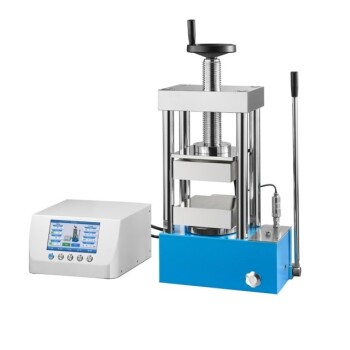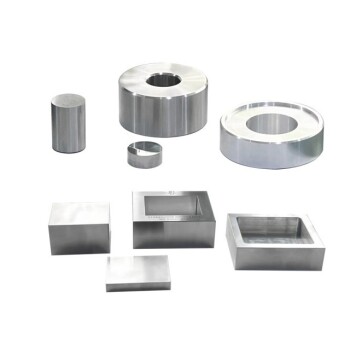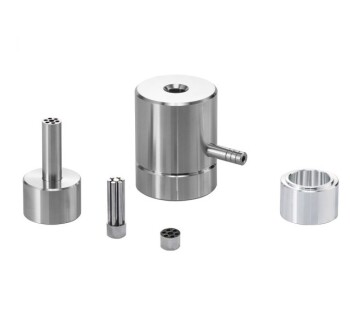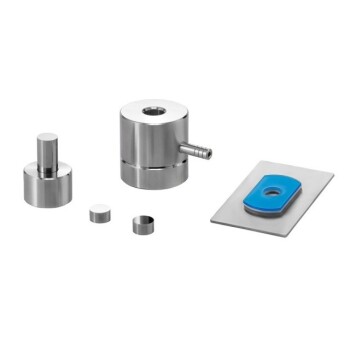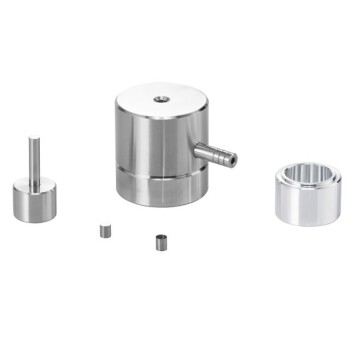When selecting a laboratory hot press, the most critical factors to evaluate are its temperature range, pressure capacity, and platen size. These core specifications must align directly with the requirements of your materials and the dimensions of your samples or molds to ensure successful and repeatable processing.
Selecting the right hot press is not about finding the machine with the highest specifications, but about making a precise match between the equipment's capabilities and the specific demands of your scientific application. An improper choice can lead to failed experiments, inconsistent results, and wasted investment.
Core Technical Specifications: Matching the Machine to Your Material
The fundamental purpose of a hot press is to apply controlled heat and pressure. Your first step is to define the absolute requirements dictated by your specific material or process.
Temperature Range and Control
The press must be able to reach and maintain the temperatures your process requires, whether for curing polymers, sintering ceramics, or bonding composites.
Look for a wide temperature range to accommodate future projects. More importantly, evaluate the control accuracy and uniformity across the platens, as precise temperature regulation is crucial for achieving desired material properties.
Pressure Capacity and Uniformity
Pressure is a function of the total force applied over the platen area. You must ensure the press can generate the required pressure (psi or MPa) for your specific sample size.
Consider the power system that generates this force—manual, pneumatic, or hydraulic. Hydraulic systems typically offer the highest force, but the key is ensuring the pressure is applied uniformly to avoid inconsistencies in your finished sample.
Platen Size and Material
The platen size dictates the maximum size of your sample or mold. Always choose platens that are larger than your largest planned sample, leaving a sufficient margin around the edges for handling and to ensure even pressure distribution.
The platen material itself is also a factor, as it must withstand the required temperatures and pressures without warping or degrading over time.
Heating and Cooling Rates
The speed at which the press heats up (ramp-up rate) and cools down is a critical process parameter for many materials.
Slow, controlled heating can prevent thermal shock in brittle materials, while specific cooling rates can influence crystallization and final mechanical properties. Ensure the machine's rates match your procedural needs.
Environmental and Operational Requirements
Beyond the core specifications, you must consider how the press will fit into your laboratory environment and workflow. These factors directly impact usability, repeatability, and safety.
Vacuum and Atmosphere Control
If your materials are sensitive to oxygen or moisture at high temperatures, a press with vacuum or inert atmosphere capabilities is non-negotiable. This feature prevents oxidation and allows for processing in a controlled environment, which is essential for many advanced materials.
Automation and Data Logging
For processes requiring high repeatability or for quality control applications, automation is key. A system with programmable cycles for temperature, pressure, and time ensures that every run is identical.
Data logging provides an essential record of process parameters for analysis, troubleshooting, and compliance documentation.
Physical Footprint and Lab Integration
A hot press is a significant piece of equipment. You must account for its physical dimensions, weight, and utility requirements.
Confirm you have adequate space, a stable foundation, and the correct electrical power supply. Some larger hydraulic systems may also have specific installation or ventilation needs.
Understanding the Trade-offs and Hidden Costs
Choosing a hot press involves balancing performance with budget. Understanding the inherent trade-offs will help you avoid common purchasing mistakes.
Manual vs. Powered Systems
Manual presses are the most cost-effective and are suitable for applications where exact pressure is not critical. However, they lack the precision and repeatability of powered systems.
Pneumatic or hydraulic presses offer superior force control and automation but come at a higher initial cost and may have a larger footprint.
The Cost of Overspecification
It can be tempting to purchase a machine with the highest possible temperature and pressure ratings "just in case." This is often a mistake.
Overspecifying a press leads to unnecessary capital expenditure and potentially higher energy consumption. A realistic assessment of your current and near-future needs is the most cost-effective approach.
Safety Features and Long-Term Reliability
Do not overlook safety. Look for essential features like safety guards, emergency stop buttons, and over-temperature protection.
Finally, consider the manufacturer's reputation and support. A reliable machine from a reputable brand may cost more upfront but will save you significant time and money in the long run by avoiding downtime and maintenance issues.
Making the Right Choice for Your Goal
Select your hot press by prioritizing features that align directly with your primary objective.
- If your primary focus is fundamental materials research: Prioritize precision control over temperature and pressure, data logging capabilities, and options for atmosphere or vacuum control.
- If your primary focus is quality control or pilot production: Emphasize automation for repeatability, platen size for throughput, and robust construction for long-term reliability.
- If your primary focus is education or exploratory testing: Focus on user safety, ease of operation, and overall cost-effectiveness, where a manual or smaller powered press may be sufficient.
A well-chosen hot press becomes a reliable partner in your work, enabling consistent and accurate results.
Summary Table:
| Factor | Key Considerations |
|---|---|
| Temperature Range | Must match material needs; ensure wide range and precise control for uniformity |
| Pressure Capacity | Check force (psi/MPa) and uniformity; consider hydraulic, pneumatic, or manual systems |
| Platen Size | Should exceed sample dimensions for even pressure and handling |
| Heating/Cooling Rates | Align with material requirements to prevent thermal shock or control crystallization |
| Vacuum/Atmosphere | Essential for oxygen-sensitive materials to prevent oxidation |
| Automation/Data Logging | Ensures repeatability and provides records for analysis and compliance |
| Physical Footprint | Assess space, weight, and utility needs for lab integration |
| Safety & Reliability | Look for guards, emergency stops, and reputable manufacturer support |
Ready to enhance your laboratory's capabilities with the perfect hot press? KINTEK specializes in high-performance lab press machines, including automatic lab presses, isostatic presses, and heated lab presses, designed to meet the precise needs of materials research, quality control, and educational labs. Our solutions deliver superior temperature control, uniform pressure, and reliable automation to boost your efficiency and accuracy. Contact us today to discuss your requirements and discover how KINTEK can support your scientific success!
Visual Guide
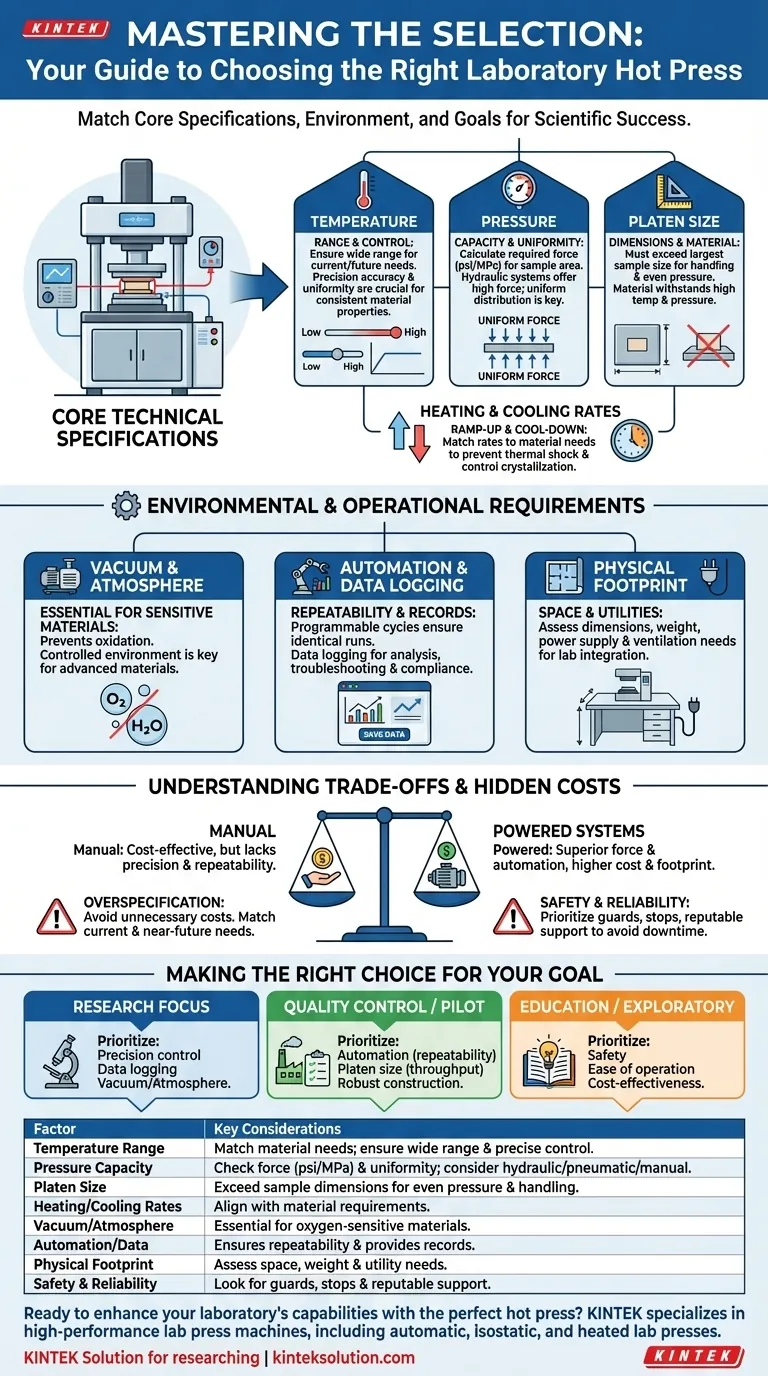
Related Products
- 24T 30T 60T Heated Hydraulic Lab Press Machine with Hot Plates for Laboratory
- Automatic High Temperature Heated Hydraulic Press Machine with Heated Plates for Lab
- Lab Heat Press Special Mold
- Heated Hydraulic Press Machine with Heated Plates for Vacuum Box Laboratory Hot Press
- Manual Heated Hydraulic Lab Press with Integrated Hot Plates Hydraulic Press Machine
People Also Ask
- How do hydraulic hot press machines enhance operational efficiency? Boost Productivity with Precision and Automation
- How is a hydraulic heat press used in laboratory sample preparation? Create Uniform Samples for Accurate Analysis
- Why is a hydraulic heat press critical in research and industry? Unlock Precision for Superior Results
- What role do heated hydraulic presses play in manufacturing composite materials? Enhance Strength and Precision in Production
- What is the primary function of a hydraulic heat press? Achieve Precise Bonding and Shaping with Controlled Force and Heat
